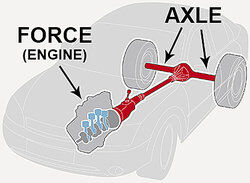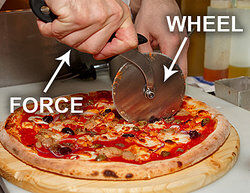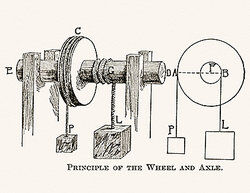
Ferris Wheel Axle
You can see examples of a wheel and axle simple machine in everyday life. Exploring everyday examples can help you understand this simple machine: it’s a basic mechanical device with few moving parts used to modify motion and force. A wheel and axle machine is a type of lever.
What Is a Wheel and Axle?
Simple machines, like a wheel and axle, are used to help move items or lift objects and people. There are two main parts:
- Wheel: Round disc, or the larger, rounded part on the outside
- Axle: Rounded cylinder, or smaller rounded rod on the inside
The axle runs through the center of the wheel and can be attached to another object. The use of a wheel and axle is a great demonstration of cause and effect.
Common Wheel and Axle Examples
Wheel and axle uses include lifting heavy objects, moving people quickly, and moving parts of a complex machine. There are two basic types of wheel and axle simple machines.
- A machine where the force is applied to the axle
- A machine where the force is applied to the wheel
Examples of Force Applied to Axle
Applying a large force to the axle makes the wheel go faster. Everyday examples of this type of wheel and axle include:
- Bicycle
- Car tires
- Ferris wheel
- Electric fan
- Analog clock
- Winch
In all these examples, you can see how the motion is initiated from the axle, resulting in a larger motion by the wheel.

Examples of Force Applied to Wheel
When you apply a small force to the wheel, it travels a longer distance and creates a stronger force on the axle. Everyday examples of this type of wheel and axle include:
- Screwdriver
- Drill
- Windmill
- Water wheel
- Doorknob
- Pizza cutter
- Skateboard
In contrast to the examples where the force is applied to the axle, these examples illustrate when the motion is initiated from the wheel.

How Does a Wheel and Axle Work?
Some type of force makes either the wheel or the axle move. That motion causes the other part of the machine to move. The wheel rotates around an axle, or fulcrum, so it can keep moving. You can add grease to an axle to decrease the friction between the axle and wheel.

When two objects rub together, like sliding a heavy log across the ground, it causes friction and makes it difficult to move the log. Wheels reduce or eliminate that friction, like when you place heavy log in a wheelbarrow. Since the friction is reduced, it takes less energy to move the load.
What Is Mechanical Advantage?
Mechanical advantage is a term used to rate how well or poorly a wheel and axle machine performs. Mechanical advantage describes the ratio of output force, or the force put out by the machine, to the input force, or the force put on the wheel or axle. It basically looks at how much work the machine does versus how much work a person does to work the machine.
What Was the First Wheel and Axle Machine?
Experts believe the first example of a wheel dates back to 3500 B.C. In Mesopotamia, the wheel was first used for a type of potter’s wheel. While the first versions of the potter’s wheel may not have been great wheel and axle examples, early potters did get to the point of developing pottery wheels for their purposes.
Simple Machines For Everyday Life
There are five other types of simple machines you see used every day: lever, wedge, pulley, screw, and inclined plane. Explore the machines you use in your everyday life to see which type of simple machines they are.